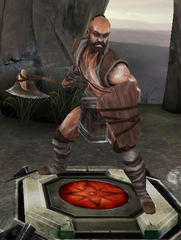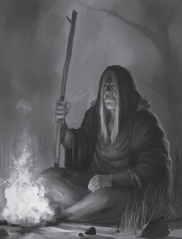The Chasind are a human tribe dating back to ancient times. They are also known as Chasind Wilders to the outsiders.[1]

History
- -2415 Ancient, Alamarri tribes first passed across the Frostback Mountains into the land that is now known as Ferelden.[2] A millennium later, in -1415 Ancient, some split away and moved into the Korcari Wilds, which is a harsh environment of forests and swamps in the far south. These tribes became known as the Chasind,[3] an enigmatic (albeit largely peaceful) people with shamanistic traditions and a great respect for magic.[1][4]
- In -715 Ancient, the Tevinter Imperium began a series of campaigns meant to subjugate the southern human tribes.[5] One of the magisters leading the assault in -712 Ancient noted that the plan was to first deal with the Avvar and then focus their efforts on the Chasind and the rest of the Alamarri.[6] After facing many difficulties, the Imperium succeded in holding the southern expanse of the continent and eventually expanded the Imperial Highway all the way to Ostagar,[5] which was a fortress built to watch out for Chasind incursions.[7]
- Following Tevinter's collapse caused by the First Blight, most imperial outposts were abandoned, including Ostagar.[7] In -184 Ancient, the Tevinter Imperium's influence in southern Thedas significantly diminished as Minrathous started to rebuild.[8] The Chasind took this opportunity to claim Ostagar.[9] Eventually, the fortress was abandoned by the Chasind.[10]
- In 1:40 Divine, following the defeat of the Darkspawn by the Alamarri (united under the warrior Hafter), the Avvar and Chasind combined their forces and invaded the lands held by the Alamarri, hoping to take advantage of the chaos.[11][12]
- In 1:50 Divine, Hafter finally defeated both the Avvar and the Chasind. Numerous battles were fought with both tribes, ultimately driving the Avvar deep into the Frostback Mountains and the Chasind back into the Korcari Wilds.[13][14]
- There are conflicting accounts regarding the involvement of Flemeth with the Chasind. One Fereldan tale claims that Flemeth, a Witch of the Wilds, gathered an army and invaded the Ferelden Valley, only to be slain by the hero Cormac. However, according to Morrigan, while the Chasind invaded the lowlands of the Alamarri at some point, Flemeth had nothing to do with it. She also claims that Cormac led a brutal civil war against his own people under the pretense of vanquishing an evil that had taken root amongst the lords, and that Flemeth was only attached to the legend later.[15]
- Some accounts of Chasind's origin refer to them as a "strange twisted people plagued by dark desires". According to old tales, many years after they parted from the Alamarri, the Chasind invaded the Fereldan valley accompanied by “white shadows” and swamp creatures. It's said that they conquered the Alamarri for a time, however, the events are highly disputed, including how long the subjugation lasted and whether it actually happened. In the end, the Alamarri killed the Chasind shamans and drove their warriors back to the Korcari Wilds.[16][17]
- In the Towers Age, the legendary witch Flemeth rose as a terrible power amidst the Chasind. Her daughters, the Korcari witches, led an army of wilders and other, more terrible things, against the north. Their forces ravaged the Fereldan valley until Cormac gathered an army of Alamarri fighters and Orzammar dwarves. The Chasind got defeated in a long series of battles, and the witches were burned. The conflict caused Fereldans to regard the Chasind with suspicion and hatred for ages to come.[16][17]
Involvement
Dragon Age: Origins
In 9:30 Dragon Age, the Fifth Blight began in the Korcari Wilds, driving many Chasind refugees from their homes and north into Ferelden.[18]
Dragon Age: The Veilguard
The strange, new darkspawn that Elgar'nan and Ghilan'nain had deployed to southern Thedas have spread fear and corruption greater than any previous Blight in history. Ferelden would have fallen had it not received crucial aid from Orzammar. Nevertheless, Denerim was lost and the Fereldans are holding the line at Redcliffe.[19]
Sometime later, a splinter faction of the Orlesian nobility has made common cause with the Venatori and launched an assault on both the royal forces of Orlais and the border keeps of Ferelden. To make matters worse, darkspawn in great numbers have been spotted near the ruins of Ostagar and have begun invading from the south.[20]
The Inquisitor sent envoys to both the Chasind and the Avvar. They and the leaders of Ferelden have agreed to an alliance, at least until the present threat passes. This alliance has stabilized Ferelden for the time being and turned the war against the Blight into a stalemate.[21]
Despite winning several battles against the Venatori in Orlais and the Antaam in the Waking Sea,[22] the darkspawn have proliferated to an astronomical rate. The Fereldan Alliance has been forced to abandon villages and settlements across southern Ferelden. The Inquisitor's forces have retaken Skyhold from the demons that occupied it and are using it to shelter Fereldan refugees. The hordes of darkspawn have conquered Redcliffe and the shores of Lake Calenhad writhe with the blight's corruption. The Fereldan land is so corrupted that there are fears that even should there be survivors of the Blight, the surviving Fereldans will die of starvation instead. Skyhold in the meanwhile, has to rely on Avvar and Chasind hunting parties to sustain itself. The Free Marches have unified under a single banner and marched south to aid the Fereldan Alliance.[23]
Culture
The Chasind mostly keep to themselves contemporarily. Years of separation from the Alamarri (i.e., the Avvar, Clayne, and modern Fereldans) sharing Ferelden Valley with them has led them to develop their own unique culture—including their own language, though they are capable of conversing in the King's tongue.
While the Chasind have waged war on both the Tevinters and on the inhabitants of Ferelden in the past, today they are considered a largely peaceful people; although they are still viewed as primitive and barbaric by the people of Ferelden. They try their best to live out decent, if misunderstood, lives in the Wilds: painting their faces and banding together in small communities led by shamans.[1] Despite this, they face many raids from templars,[24] and persecution from Fereldans.[25]
There are many tales of these shamans having learned their magic from the "Witches of the Wilds": witches that inspire as much terror as they do awe and gratitude, even if there is no definitive proof they exist. In particular, the tale of Flemeth, the greatest witch of the wilds, is celebrated amongst all tribes.[1]
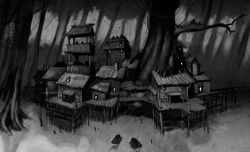
Chasind live out their lives in small villages made up of houses and strange-looking huts built on stilts, or even into the great treetops of the Korcari Wilds. Some Chasind are even said to eke out an existence in the frozen wastes that await beyond the Wilds; to this day the Ferelden eye the south warily, regarding the Chasind with suspicion, hatred, and fear the day a charismatic figure will unite them once again.[1][17][26]
Chasind respect those with survival skills in the Wilds,[27] and have designed a system of leaving behind hidden markers and signs in piles of stone and rubble. In this way, they mark trails, note places of interest, and even give warnings in a way outsiders cannot understand. Interestingly, these markers look indistinguishable from a regular pile of stones.[28]
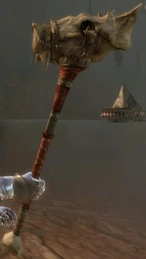
Much of Chasind culture is a mystery, but they are known for their animistic beliefs, their tendency towards superstition and that they do believe in the presence of gods of some kind. In particular they believe that some men or women are beloved by the gods, and some of their weapons have thus been shaped into the likeness of animals to combat such people; the theory being that, upon a Chasind slaying someone favored by their gods with said weapon, the gods would be confused and might blame the animal that the weapon is modelled after instead.[29]
Traditionally, the Chasind personify the seasons as female warriors, bearing the typical attributes of renewal and death. Winter is of note for its brutality, as it is tied to their rumored custom of killing those who flee battle. Old statues of these warriors depict women with animal heads.[30]
Other Chasind weapons, like their bows, also tend to bear strange markings and symbols,[31] often inspired by nature.[32] Chasind are also known for their brawn, as many of their weapons require great strength to be used effectively in battle.[33] However, one of their most valued weapons are the flatblades (swords that are only given to the most prominent of their warriors). Indeed, none but a few of their shamans know of how to craft such a weapon.[34]
Chasind works of art seem primitive at best. Pendants and charms carved from the fangs, bones or claws of animals seem to be the most common,[35][36] alongside fertility carvings.[37] Likewise, their clothing is perhaps of questionable quality—sometimes merely pieced together from ragged strips of leather and adorned with the teeth and bones of animals; they also smell strongly of tanned hides and sweat.[38] Even their helmets are often designed more for intimidation, rather than protection.[39] Chasind are known to decorate their hair with pierced copper coins; these are tied into the ends of their braids. [40]
However, Chasind are not ignorant when it comes to crafting. For example, the Chasind have found ways to induce hallucinations through extracts of the leaves of Deathroot;[41] and their skill in Herbalism further allowed them to create ice salves to protect themselves from the cold winters of the Wilds.[42][43]
They are also known to brew mead[44] and an alcohol called wildwine, which is not actually a wine but a grain alcohol made from ryott, a protein-rich crop valued throughout Ferelden, traded to them from southern villages.[45] Wildwine is much stronger than beer, but similar to their mead,[46] and is a favored beverage among the Chasind.[47] Roast turkey and grilled poussin are common Chasind fare. Traditionally, the poussin is cooked in a big pot on an open fire where it is regularly basted and marinated for an extended period of time, till the flesh becomes tender.[48]
Some Chasind do not raid and kill out of necessity. However, some deliberately inflict slow and painful deaths on their victims, seemingly out of cruelty.[49] Indeed, some Chasind are reputedly so barbaric that they even consume the flesh of the dead.[50]
South of the Korcari Wilds, there are so-called Sunless Lands.[51] The Chasind consider these lands to be dangerous and forbidden. The region is largely inhospitable as it spends most of the year covered in snow. However, the Sunless Lands are inhabited by people who are called "Agadi" by the Chasind, which means "exile" in their language. Genitivi theorizes that the Agadi have been expelled from the Korcari Wilds and splintered off into their own culture.[52]
While most Chasind do tend to live peaceful lives, there are some among them that favor bloodshed. Hardened by the harsh conditions of the Wilds that do not suffer fools lightly, the primitive nature of the Chasind do incline some tribes to take by force or stealth anything they cannot grow or build for themselves - which is to say, almost everything worth having. Chasind raiders, known within Ferelden as “stalkers,” often slip out of the wilds traveling in small scavenging parties to search for easy targets amidst the freeholds of the south. The Chasind are famed (and cursed about) for their stealth and hunting skills, both of which they employ to track down suitable targets. They favor vicious ambushes using short bows with wickedly hooked arrows. Stalker groups are invariably small, to deflect attention, and likely to be lightly armored in patchwork leather, so as to move with speed.[53][54]
Known Chasind
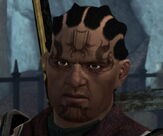
- Cahir – a torturer in service of Prosper
- Doomsayer – a man whose family was killed by darkspawn
- Velcorminth – war leader at the time after the Second Blight[55]
- Morrigan's father – it's implied he was likely of Chasind origin[56]
- Cole's mother[57]
- Baba Zorya – a Chasind living in the Korcari Wilds[47]
- Old Stoyanka – a Chasind wisewoman living in the Korcari Wilds[58]
Known Chasind settlements
- Tombigbee – the only major settlement in the Korcari Wilds, nicknamed the "stilt-city"; its location is known only to the Chasind[59]
- Dosov[47]
Codex entries
 Codex entry: The Chasind
Codex entry: The Chasind Codex entry: The Korcari Wilds
Codex entry: The Korcari Wilds Codex entry: Letter to Jogby
Codex entry: Letter to Jogby Codex entry: Ostagar
Codex entry: Ostagar Codex entry: Signs of the Chasind
Codex entry: Signs of the Chasind Codex entry: The Women of All War
Codex entry: The Women of All War
